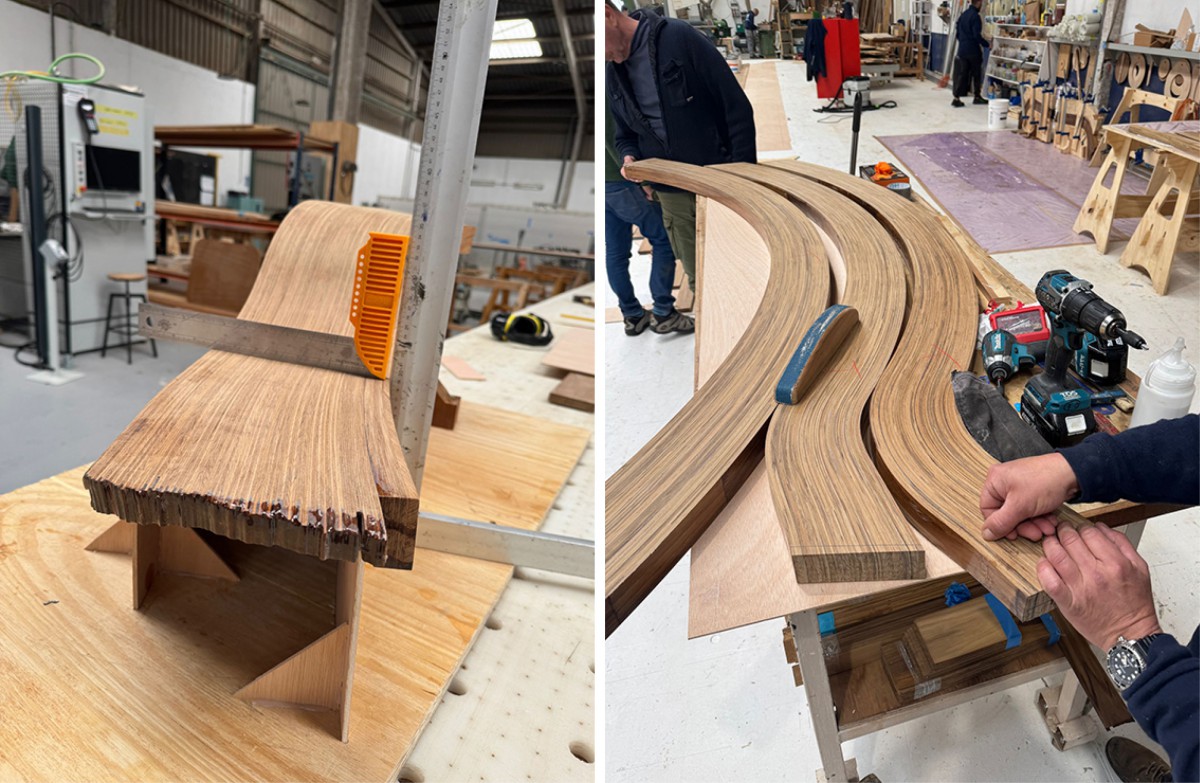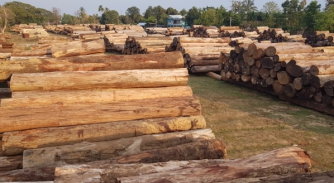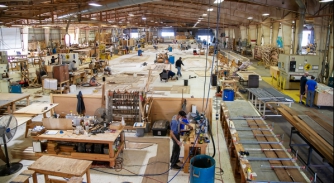Build it and they will come
An interview with Richard Strauss, CEO of Teakdecking Systems, on ethical and sustainable teak alternatives that offer all the properties owners are looking for…
As part of News Editor Conor Feasey’s deep dive into the thorny topic of teak in our recent Captains issue of The Superyacht Report, he spoke with three of the top suppliers about the alternative deck materials that offer all the properties owners are looking for while being both ethical and sustainable.
Their responses are being published in three parts – here is the first; parts II and III will follow in the coming days.
Teak might still be the deck king, but is the kingdom is on borrowed time? Richard Strauss, CEO of Teakdecking Systems, has spent over a decade meticulously testing alternatives, stress-testing supply chains and preparing for what he saw as the inevitable shift.
In this conversation, he lifts the lid on what’s actually viable, why green teak might be the sleeper hit and how the next generation of owners is asking very different questions than their predecessors ever did.
There’s this idea, which a lot of people in the industry will resonate with, that the ultra-rich want what the ultra-rich want. And ultimately, they’re going to have it. Do you think that’s changing at all?
Well, we hear fascinating stories from our clients, whether that is designers, naval architects, project managers, yacht management groups and captains. And yes, we’re starting to hear it in drips and drabs. Things like a seasoned superyacht owner’s grandchild asking, “Where’s this stuff coming from?”
So grandpa’s building a new boat and the grandkids are starting to ask those questions. They want to make sure that sustainable initiatives are being taken. How prevalent that is across the industry, I don’t know. But it’s happening. There’s definitely a change.
I’d say we saw a drastic shift three years ago at METSTRADE. It was the first time we noticed how the questions people asked us differed; the way people approached us had changed. And since then, it’s just continued. That felt like the first wave of a groundswell that’s still building.
Do you see that awareness is stronger in Europe than in the US?
Oh, 100 per cent Europe, and the kinds of questions we get from them, they’re probably five years ahead of where we are in the US. Over here? We’re not building a ton of superyachts any more. We’re still running around with centre consoles with six outboards on the back and jacked-up pick-up trucks, so there’s still a cultural gap.
But we are getting a lot of interest in cork decks – and that’s growing. We’ve been promoting cork, not heavily, but the appetite is there. People are starting to get inquisitive about sustainable options and real alternatives.
“It’s all about education. It’s a new product, it’s different and yes, people are suspicious
of ‘new’ in this space, but it’s starting to gain traction.”
What do you think is driving that shift? Is it education, sustainability awareness, or are people genuinely questioning the ethics behind sourcing teak?
It’s probably all of those. We still work with the same wood traders, but our wood-sourcing team spends a lot of time on the ground in the forest, at the log depot, at the mills. We check all of it out. We want to understand the whole supply chain. That includes making sure the sawmills are operating ethically – no child labour, no shady practices. We’ve walked away from loads of wood because we saw something at a mill that didn’t sit right. That’s always been our approach.
Since the coup in Myanmar in 2021, we’ve accelerated that effort. Because of the size of our operation, we're being watched very closely. But to be honest, we knew the end of the runway was coming for Myanmar teak; we just didn’t know when. So we’ve been exploring plantation teak options for over a decade.
What does that process look like when it comes to verifying sources?
You must be extremely careful. India, for example, is closely tied to Myanmar, so a lot of teak moves through there and it can get muddy. That’s why we physically visit the forests, the depots and the mills.
Now, we’re doing DNA and isotope testing. We’ll pull boards from a load and send them off for analysis, which can tell us exactly where the teak came from.
So when a wood trader gives us paperwork that says, “This is where your log came from”, we can back it up. We do that as an insurance policy for our clients. We work with a company called Double Helix for third-party verification. They’re cautious, they’re thorough and we trust them. But even then, we take it one step further with the testing.
And are there regions you’re finding promising sources from?
We’re looking in India, Indonesia, Brazil and Costa Rica. The nicest wood we’ve seen lately is probably from India. Indonesia can produce great wood, too, but it takes time to source the quality and quantity we typically need, sometimes up to one and a half years.
A company in Thailand is doing something interesting with what’s called ‘green teak’. They’re cutting down 30-year-old trees, slicing them into 1.2 or 1.5mm veneers, glueing those together and creating these teak blocks. It’s a manufactured teak product, but it mimics vertical-grain teak and that’s what we want when we build a deck.
So what’s the advantage of that technique over using a natural vertical grain cut?
When we cut a traditional log, we get maybe 10 to 12 per cent vertical grain yield. That’s it. The rest is waste for our purposes. But with green teak, we’re slicing, glueing and reconfiguring the veneers so they appear as vertical grain. That gives us about an 85 to 90 per cent yield from the log.
You’re getting a structurally strong product from a 30-year-old tree. On its own, a 30-year-old tree won’t give you premium vertical grain – the grain’s too wide. But when we manufacture it like this, we can control the outcome. The content is strong, the material weathers well and it looks and performs like traditional teak. It’s a good product.

Green teak, which looks and performs like traditional teak.
Why hasn’t green teak become more widespread, then? And why is that development still so limited to Thailand?
Green teak’s actually been around for a while now. We’ve been working with a supplier in Thailand for probably 10 or 11 years. He’s been sending us samples and we’ve been putting them through their paces. We’re based in a subtropical climate, so lots of rain, lots of sun, the kind of environment where if something’s going to fail, it’ll fail fast. So we’ve been testing this stuff thoroughly.
At first, there was understandable apprehension. You’re looking at a board made from multiple teak veneers all glued together and obviously, people ask, will that come apart? But the company in Thailand has really refined its process over the years. He’s figured out how to bond it properly.
Do you ever see seam separation? Occasionally. But no more than you’d get with a cracked solid teak batten. And the fix is easy: you just rout out the damaged bit, drop in a new veneer and you'd never know once it’s weathered in. It’s seamless.
So the shift is really towards green and plantation teak?
Right. Green teak and plantation teak are the most viable options. But it’s not just about having it, we need time. We need a year and a half to build enough quality product to meet the client's expectations. That’s part of the education process, training the designers, project managers, the whole chain.
And outside of teak, where is innovation happening?
Cork and composite. We just finished a refit on a 78-metre superyacht. We used teak on 80 per cent of the boat, but composite on the bow, in the tender garages and on the helipads. These are high-use, high-wear areas. Composite makes more sense there because it’s easier to maintain and cheaper to repair if it gets damaged by tenders or heli skids.
This wasn’t a reaction to the coup in Myanmar. We’d already started shifting this way five or six years ago, because teak was getting so expensive. Why would you use beautiful, expensive wood in a tender garage? Up on the bow where the ground tackle is? That’s a working area. No guests go up there. So let’s put composite up there and if it gets damaged, we fix it. Easy.
Let’s talk about cork. What about it exactly is garnering this attention?
Cork has been the biggest hang-up. Walking on a cork deck feels great underfoot; soft, comfortable, just like teak. That tactile feel is a big part of why people love teak. Cork gives you that. Visually cork lacks the character that the grain of a natural teak deck has, but it can still have the traditional seams and look great. Conversely, cork does allow total design freedom similar to our composite decking if the designer or owner wants to get creative with a design feature other than the traditional “teak plank look”.
From a maintenance perspective cork is easy. It greys out like teak, and you can clean it with a light sanding or a cleaner like our Eco 100 cleaner. We've conducted extensive testing. In our lab, we cut holes in cork decks and determined how to repair them without the patch being visible. We know our cleaners and sealers work on it. We can offer a full maintenance package. The functionality is there, it’s just the aesthetic that needs to win people over.
Are you seeing any trends in the types of clients who are more open to alternatives like cork? Private vessels? Charter boats? Any patterns by size or type?
To my knowledge, I haven’t seen anything of substantial size using cork as a full deck yet. That visual element is still an obstacle. It’s going to take someone willing to step out and take the risk before we see that shift at scale. But we are seeing it more in tenders on superyachts or smaller areas within yachts, like a gym or maybe a wellness area. I haven’t seen it used in tender garages yet, but I think that’s coming. Sailboats are picking it up quicker. They’re more weight-conscious and that sailor mindset tends to be more sustainability-minded, too. They’re using wind power and free energy, and that thinking carries over to the materials they use.
There’s great potential for cork in the electric boat market, especially with catamarans and some of the new hydrofoils coming out now. All those vessels are extremely weight-sensitive. Cork decks are a great solution for that. They’re lightweight, easy to maintain and sustainable.

Cork allows design freedom if the designer or owner wants to get creative with a design feature
other than the traditional “teak plank look”.
Still, you’re building $150 million superyachts. That must be a hard sell to someone used to traditional teak?
Exactly. When you’re spending that kind of money, you want assurance that your deck will hold up, structurally and visually. But we’ve had a client recently, a very seasoned superyacht owner, who was willing to put it to the test.
He originally wanted ethically sourced teak, looked at composite and then heard about green teak. So we built him a couple of big hatches using green teak, not for the final yacht, just as trial pieces. He put one on the bow of his current yacht and one on the swim platform.
Then he spent a year deliberately trying to destroy them. He had the crew acid-wash them daily. The one on the swim platform was constantly hit by wash. He later moved up onto the sea wall next to the passerelle. They ran hand trucks over it, gave it hell. And it held up. That gave him the confidence to specify it for his new build.
It’s all about education. It’s a new product, it’s different and yes, people are suspicious of ‘new’ in this space, but it’s starting to gain traction. Slowly, but it’s coming.
Seeing the projects in action, how the decks weather over time, how well they hold up and how well they repair now gives people more confidence?
A select group of people on the planet, millionaires and billionaires, are willing to take that step and be a little more adventurous. And when one or two of those actually do it and it proves to be a viable option, then you’ve got something. It’s dock talk. Once you get one or two good examples out there, it spreads like wildfire.
We’re also a super conservative company in a relatively conservative industry. We’ve been testing this for ten years before we even considered releasing it or talking about it publicly. But with the way things are shifting, we finally felt confident enough to say, ‘Yes, this is ready’.
Finally, what other innovations have you found to make teak itself more sustainable or economical?
I hate to say it, but there’s not going to be anything economical about teak decking. If you want a quality decking surface, it’s teak or a variant of teak. That could mean plantation teak or green teak; those are the teak options in today’s world. Unless you’ve got old Burmese teak that was purchased and imported legally before the ban, and even then, people are wary.
The problem is, anything labelled ‘Burmese teak’ is a bit taboo now. Even if it was bought legally ten years ago and has sat untouched in inventory, people don’t want it. It’s like wearing a fur coat in New York City in the early ’90s. But at the end of the day, the ultra-wealthy want what they want. So our job as an industry is to figure out how to supply them with what they want, but in an ethical way.
NEW: Sign up for SuperyachtNewsweek!
Get the latest weekly news, in-depth reports, intelligence, and strategic insights, delivered directly from The Superyacht Group's editors and market analysts.
Stay at the forefront of the superyacht industry with SuperyachtNewsweek
Click here to become part of The Superyacht Group community, and join us in our mission to make this industry accessible to all, and prosperous for the long-term. We are offering access to the superyacht industry’s most comprehensive and longstanding archive of business-critical information, as well as a comprehensive, real-time superyacht fleet database, for just £10 per month, because we are One Industry with One Mission. Sign up here.
Related news

Oceanco settles teak court case
The shipyard’s unintentional breach of the EUTR is a clear indication of the challenges we face with an increasingly convoluted supply chain
Crew
-environmental-investigation-agency-(eia).jpg)
Sunseeker sentenced for ‘blood’ teak
The British boatbuilder has been fined over £350,000 in a landmark case in the UK courts for importing teak from Myanmar
Crew

Are yards doing the hard yards?
Are new-build shipyards doing enough to improve their in-house sustainability processes as the clock ticks down to the looming deadline of 2030?
Crew

The teak critique
We analyse the sustainability of the desire for teak decking in view of the projected increase in demand from yachts in refit
Owner
Related news
Oceanco settles teak court case
1 year ago
Sunseeker sentenced for ‘blood’ teak
1 year ago
Are yards doing the hard yards?
2 years ago
The teak critique
2 years ago
NEW: Sign up for
SuperyachtNewsweek!
Get the latest weekly news, in-depth reports, intelligence, and strategic insights, delivered directly from The Superyacht Group's editors and market analysts.
Stay at the forefront of the superyacht industry with SuperyachtNewsweek



